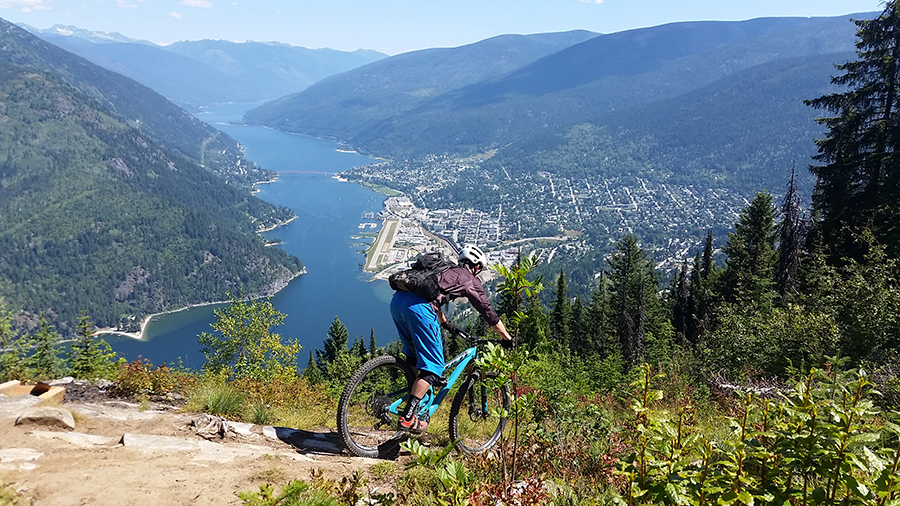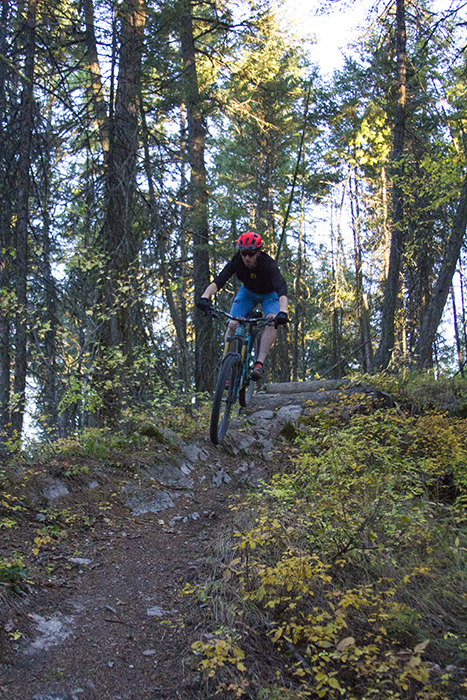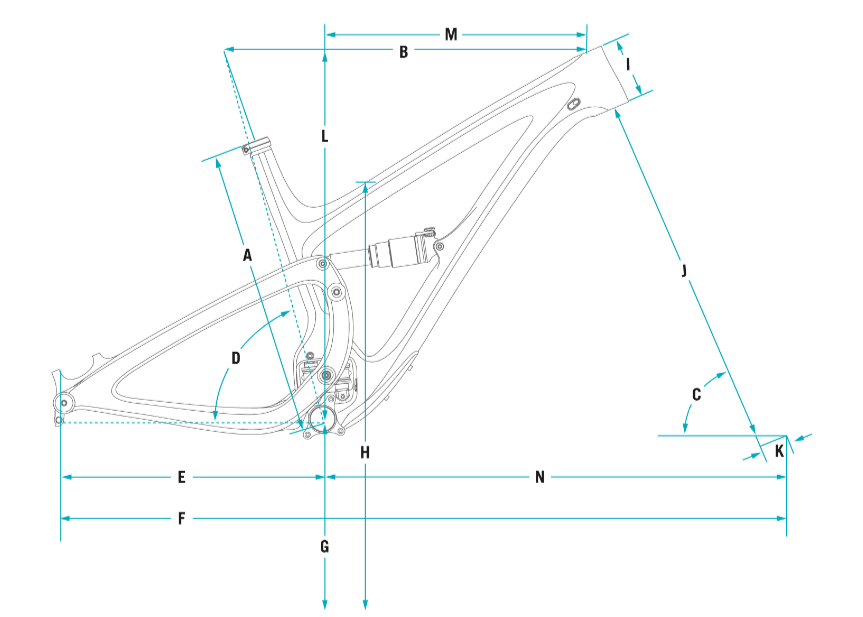The Build
I rode the SB5.5 with the X01 build kit, which is replaced for 2017 with a Sram Eagle kit. The X01 build is a solid performer – it’s lighter and has better range than a Shimano XT drivetrain, and it worked (almost) perfectly throughout my time on the bike. My only gripe has to do with the rear derailleur’s well known proclivity for rattling out of the frame – I had to tighten mine down once or twice. This happens to every single Sram X-Horizon (i.e. 11 speed) rear derailleur I’ve used, but it can be solved with a liberal dose of blue loctite on the mounting bolt.
Mixed into the drivetrain are some Raceface Turbine Cinch cranks. I just called the Next SL G4 cranks the best on the market, and the Turbines have most of the upsides of the Next, but in an aluminum package. In other words, they’re great, and a bit less expensive.
Braking duties were handled by Sram Guide RSC’s mated to 180 mm rotors front and rear. No complaints there, although as with pretty much all Sram brakes, I have to fuss around with the bleed and pad advancing to get the lever to pull like I want.
The SB5.5 is suspended by Fox – a Float 36 Factory Fit4 fork and a Float X rear shock. While Rockshox and Fox seem to trade places for “best in class” on an almost yearly basis, at the moment, I think the Fox products are a bit better.

The 36 fork is stiff, consistent, and does an excellent job of absorbing bumps while also providing support when it’s needed. At 160 mm of travel, the fork also makes the bike’s intentions pretty clear – go fast, and run into stuff. Personally, I’d take the non-Fit4 version of the fork that has independent high speed and low speed compression adjustments, but I might be in the minority there. I don’t tend to switch between climb / trail / descend very often on my fork, so I’d rather have the extra adjustability of the other version.
The Float X rear shock handles long, rough descents without getting all hot and bothered. It’s a nice middle ground of having a capable rear shock that also has a climb switch for those long slogs up steep fire roads.
Wheels on the SB5.5 are DT Swiss 350 hubs laced to XM 481 rims, which are pretty wide at 30 mm internally. The wheels were stiff and problem free in my time on the bike, although DT Swiss’s miserable hub engagement is a perpetual source of annoyance. The wide rims mate nicely to the meaty rubber that Yeti specs on the bike: a 2.5” Maxxis Minion DHF on the front, and a 2.3” Maxxis Aggressor in the back. I’m a big fan of this tire combo, and they certainly do their part to help make the bike go around corners really, really fast.
A Rockshox Reverb Stealth dropper post took care of me reasonably well, although like most Reverbs I’ve ridden, it’s going to need a rebuild pretty soon. The cockpit features an 800 mm wide Easton Havoc 35 Carbon bar and 50mm Havoc stem at one end and a color matched WTB Volt saddle at the other. That’s a solid setup that should work well for a pretty wide range of people.
The only things I changed on the build were: 1) I swapped the saddle for the Catahoula Ergonomics that I’ve been putting time on for a long term test. 2) I swapped the bar for a Raceface SixC just because I needed a slightly narrower bar and the Raceface was already cut. And 3) after a little while, I swapped the rear tire for a Maxxis Minion SS that I’m reviewing.
Fit and Geometry
Yeti has a history of making long bikes, but over time, the industry has caught up. In terms of the cockpit, the SB5.5 is fairly average by modern standards – the medium that I rode had a 421 mm reach and a 601 mm effective top tube. That’s right in the same ballpark as a lot of other bikes in this class, and it felt “right” for my 5’9” frame. Yeti says a medium will fit riders that are 5’7” – 5’11” (170-180 cm), and I’d say that’s about right. People that have an inclination for a bigger bike could probably push that a little bit (i.e. someone who’s 5’10” could run a Large), but for the most part, I think Yeti’s recommended sizing is spot on.
Where the SB5.5 pushes the boundaries a little bit is with the headtube angle and wheelbase. A 66.5° head angle is slacker than most other 29ers on the market, and makes for a decidedly stable bike at speed. The slack head tube combined with moderately long 437 mm chainstays make for a lengthy 1168 mm (in a size medium) wheelbase. With the notable exceptions of the Evil Wreckoning and the newly revised Specialized Enduro 29, not many other bikes in this class are as long.

On the issue of chainstay length, I’m of the opinion that Yeti hit a nice middle ground. Short 29er chainstays usually come in somewhere around 430 mm, while long ones might be 445 mm or more. At 437 mm, the SB5.5 gets a lot of the climbing and cornering benefits of longer stays, but still retains some maneuverability, and I don’t feel like I’m going to slip a disc trying to loft the front end.
A quick digression on seat tube angles that’s going to get a bit nerdy: a steeper seat tube angle (i.e. a number that’s closer to 90°) improves seated climbing because it keeps your weight farther forward. But seat tube angle measurements provided by manufacturers are increasingly useless – it’s a rare full suspension frame these days where the seat tube runs in a straight line to the bottom bracket, so companies list an “effective seat tube angle,” which is the angle of a straight line drawn from the bottom bracket to the seat post where it’s horizontal with the top of the head tube. Here’s Yeti’s picture – the effective seat tube angle is marked as “D”.

The problem is, most people don’t run their seat level with the top of the head tube – that’s really low. And since the actual seat tube angle is slacker, the effective seat tube angle ands up being much slacker than the number provided – the higher the seat is, the farther back it is.
So, bringing this back around to a point, the SB5.5’s seat tube angle isn’t that steep by the numbers, but the actual seat tube angle is actually a bit steeper than many other bikes. According to the geometry charts, my Evil Following has a steeper seat tube angle than the SB5.5, but by my measurements, with the seat at the same height relative to the bottom bracket, the SB5.5 is much steeper. And what that all means is that the SB5.5 climbs better while seated than the Following and a bunch of other bikes in this class because the Yeti’s seat is farther forward.
NEXT: The Ride, Durability and Maintenance, Etc.

Thanks for calling out and articulating the seat tube angle issue, which as you mention is one of the most important factors for climbing on a long travel bike. We have reach and stack to accurately define hand and front wheel position but “effective seat angle” is a shot in the dark that’s interpreted differently by each manufacturer. Hopefully some will start to listen.
Cheers
BW
This is a huge problem for taller riders. Many bikes just don’t work for them on climbs because they have too slack seat tube angles paired with short chainstays. When the seat tube is fully extended, for optimal climbing condition, weight balance gets all wrong. Bikes with a big kink in the seat tube, very slack real STA, have real world ESTAs much slacker then claimed. I seriously doubt that 2017 29er Trek Slash works for taller guys. On climbs that is.
Speaking of Evil. They actually changed their official reported ESTA on The Insurgent from the bikes inception, making them slacker. If you bother to calculate you will see that their geometry numbers don’t add up.
Of note, my Santa Cruz Hightower setup with a 160 36 on the front and Float X2 rear has numbers almost identical to the Yeti 5.5, although slightly shorter chainstays. I’ve found very much the same thing coming off my previous Nomad 3, all my Strava DH times in Western Canada terrain have come down without trying as hard.
Those of us that have tried the longer travel 29ers in my crew really think we’ll see more and more in this Enduro segment as the speed advantage seems to be a reality for most people. Interesting also to follow along on EWS setups on the few teams that have equivalent choices in 27 and 29 and ultimately what they choose. Except for Rude boy, most seem to be going the 29 route.
Hey, nice review!
Any thoughts on the comparison between this bike and the Following? Particularly with respect to running the Following with a 140mm fork. Guessing this would have the edge on the really chunky stuff (consecutive hits), I have a Following and notice it can get a little overwhelmed at the back (no surprise though).
Any thoughts appreciated
Hey Dan,
You’re correct that the SB5.5 has the edge on rough terrain, largely due to having a bit more travel. And the addition of a 160mm Fox 36 on the front of the 5.5 can’t be overlooked – it’s not just more travel, but a stiffer, burlier fork, which means you can really get away with pointing it straight into some terrible line choices.
But maybe more than anything, the Yeti just rides quite a bit differently than the Evil. I found the Yeti was happiest staying on the ground and motoring through things, whereas the Evil was a good bit more poppy and playful, and worked better when pumping every little roller on the trail. The Evil has a pretty progressive suspension, which keeps it supple off the top, and makes it a little easier to really load the back end up. The Yeti is much more linear, which means it uses all of its travel more easily, and it does a really good job of just swallowing mid sized hits.
Both are fantastic bikes, just different ways to skin the cat.
-Noah
Hey Noah,
I have ridden The Following but not the SB 5.5 and probably can’t prior to a potential purchase. The Hightower is good fun as you said, feels pretty nimble and very playful for 29. I like that the SB5.5 handles the chunk very well, but just how much do you lose in the playful/fun department? What bike would you personally choose as the daily all mountain aggressive trail bike, that can still hang in the bike park here and there? Compare it to a Mach 5.5 or Evil The Calling if you have rode those 27.5?
Hey Jake,
Compared to various 27.5″ wheeled bikes, the 5.5 just feels like a lot more bike. The long wheelbase and bigger wheels add up to a bike that feels a lot less flickable, and quick direction changes require a lot more effort. In some situations, that makes the bike feel cumbersome, in others it makes the bike feel stable; in other words, the bike’s “bigness” is a good thing some of the time. But that’s also not exclusive to the 5.5 – that’s mostly just a longer travel 29″ bike vs. 27.5″ bike thing.
As far as what I’d personally choose, that’s a tough question. I’ve been on a Hightower for the last 2 months (review coming shortly), and the Hightower feels like a bit less bike than the 5.5. Which is nice on big climbs, and more “trail” oriented rides, but I was faster on the descents on the 5.5. The 5.5 isn’t entirely unplayful, but the Hightower does better at popping and gapping between little trail features. And then bikes like the Following, Smuggler, Django 29, etc. are all fantastic, but they definitely feel smaller. Which is obviously a good thing in situations where a smaller bike is favorable, but they’re also a lot less inclined to go plowing through brake bumped chunder in a bike park situation.
So I guess the short answer to that question is that all of the bikes in this conversation have their merits, and it’s just a question of where you’d rather make some trade offs. But to narrow this down a bit, and operating on the assumption that a long-ish travel bike (130ish mm to 150ish mm) is the best choice for the trails you’re riding, I’d probably look at it like this: if playfulness and flickability are top priorities, I’d be looking at something with 27.5″ wheels. But assuming we’re mostly talking about 29ers, if efficiency is a priority, I’d look at a Hightower. If speed while retaining decent trail riding manners is the priority, I’d go 5.5. I’d probably put an Enduro 29 one notch above the 5.5, meaning it’s more about straight line speed, and sacrifices some trail manners. For unbridled DH plundering, I’d look at a Wreckoning. The new Rocky Mtn. Instinct looks interesting, but all I’ve seen are specs and pictures, so it’s too early to tell there.
Hopefully something in this semi-rambling response is helpful!